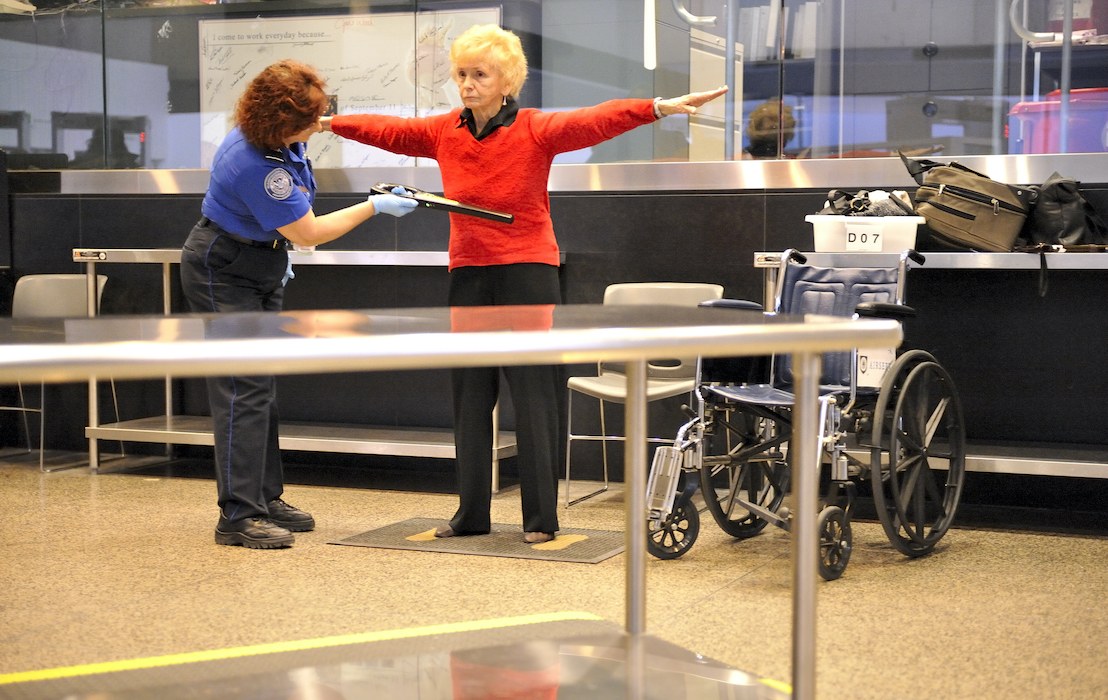[ad_1]
What a TSA show in Wyoming can inform us about our obvious powerlessness to withstand the expansion of the safety state.
The airport in Riverton, Wyoming, (inhabitants, simply north of 10,000; elevation, simply south of 5,000) is modest. Knock down the inside partitions and also you may match a center faculty fitness center within the house.
The airport homes two monuments. The first, contained within the foyer outdoors the safety cordon, is a tribute to Wyoming tradition and achievements of native sportsmen. Looking down at you as you wait to gather your baggage are two or three dozen mounts: bighorn sheep and mountain lions, pronghorns and mule deer, a black bear and a moose. Below every mount is a small plaque, naming the species in addition to the person (it’s virtually all the time a person) accountable for the kill. The taxidermies are much more fascinating, and true to the placement, than the monstrously boring and interchangeable décor one normally finds in airports.
Once you move by way of safety—a course of that one way or the other appears extra absurd than ordinary, given the diminutive measurement of the operation, with three or 4 TSA officers squeezed right into a 20-foot span of house—there’s a second monument, of kinds, taped to the wall of the ready space. Sixteen 8 ½-by-11 laminated print-offs, organized in two clusters, element the phases by which airport safety laws have grown from the formation of the FAA in 1958 to the current.
Each print-off poses a query—the form of query a “government so small you can drown it in the stock tank” Wyomingite might need requested each time airport safety grew to become extra elaborate, extra time-consuming, and extra invasive—and solutions it by citing a historic occasion. “Why are there armed officers on some flights?” (Because of “a rash of international hijackings in 1960 and 1961.”) “Why are carry-on bags physically searched?” (“Because in January 1995 five terrorists attempted to plant liquid explosive time bombs in the carry-on baggage compartments of 11 U.S.-bound international flights.”) “Why are individuals required to remove their shoes as part of screening?” (“Because in December 2001 Richard Reid attempted to blow up American Airlines Flight 63 using a bomb concealed in his shoes.”) It’s a visit down reminiscence lane—and down another, unremembered lanes as nicely.
And, simply once we thought the trickle of post-9/11 safety measures had stopped (who, in spite of everything, has time to consider Islamic terrorism right now, when now we have so many home terrorists to trace?) a brand new show has appeared: six print-offs about COVID–19. These embrace diagrams—addressed, one can solely assume, to completely functioning adults who’re capable of costume themselves, maintain down a job, and fireplace a gun—illustrating the kinds of instructions I give my three-year-old each time she has a cough (“Cover your cough or sneeze with a tissue, then throw the tissue in the trash”). Another sheet sounds extra like self-promotion than recommendation (“CDC Protects and Prepares Communities”). True to 2021, the show is rounded out by a painfully lame bureaucratic appropriation of a stale meme (“KEEP CALM AND WASH YOUR HANDS —CDC”).
The print-offs are a lot much less aesthetically pleasing than the trophies within the foyer. Yet they too are true to the native spirit, although they’ve not one of the triumphalism of the taxidermies. They document, step-by-step, the inexorable development of the safety state over a span of two generations. Even while you squint on the show, it’s onerous to make out many traces of private company, deliberation, and prudent decision-making exercised with the consent of the ruled. Instead, the mass of safety laws has emanated from a bureaucratic company or, at finest, from an elected official’s creation of an unelected company.
Considered individually, every new regulation appears to emerge inevitably as a response to occasions—typically to a single occasion—and, as soon as it has arrived, every regulation is right here to remain. There appears to have been much more “accident and force” concerned than “reflection and choice.” And so, 20 years later, thanks to 1 Richard Reid—or reasonably, due to “our” response to him—all of us nonetheless need to take away our footwear each time we fly.
Beyond piquing one’s historic curiosity, the print-offs reveal that the securitization of airline journey has operated like a one-way ratchet. One, and just one, sheet refers to a short lived measure that was subsequently suspended (“Why were computer printer supplies temporarily prohibited in carry-on and checked bags?”). When was the final time anybody talked about airport safety as insurance policies—the results of selections—that might be reconsidered and even undone? When was the final time you considered why the TSA and all its works had turn out to be “the new normal,” how efficient they had been, who, if anybody, had the facility to trim them again, and whether or not it might be clever to take action?
Surely this show is exclusive to rural Wyoming; absolutely solely a neighborhood as reflexively libertarian as this one would assume to give you such a document and show it to the general public. But the truth that it’s a monument demonstrates the folks’s powerlessness to withstand the expansion of the safety state. Each safety measure was carried out as a response to an emergency. The most this neighborhood can do is remind itself of the phases of securitization, the regular normalization of emergency measures. Who would consider re-adjusting our safety measures now that the emergency has handed? When was the final time anybody critically proposed downsizing the mass of safety laws which have collected, with little thought and fewer accountability, since 9/11?
The just lately added COVID–19 show is a reminder that now we have turn out to be comfy with the everlasting safety state, created in response to a sequence of emergencies. Better but, it’s a signal that we at the moment are habituated to dwelling in a contradiction: a everlasting emergency. Emergencies are by definition extraordinary and short-term; and they’re taken because the justification for emergency measures—once more, by definition, extraordinary and short-term. At least, that’s the way it’s purported to work. Somehow, the DHS and TSA and now CDC haven’t gotten the memo.
It is tough to think about an earlier model of the American folks—distinguished by a “manly assertion of its rights,” actuated by a “vigilant and manly spirit,” succesful of “opposing with manly firmness…invasions on the rights of the people,” and characterised by “vigilance…magnanimity and true courage”—enduring, at such value and for thus lengthy and with so little protest, the infringements on their liberty and happiness inflicted by governments in response to COVID–19. Only a folks habituated to being dominated advert nauseam by their betters would put up with a lot.
Pavlos Papadopoulos is assistant professor of humanities at Wyoming Catholic College.
[ad_2]
Source hyperlink















